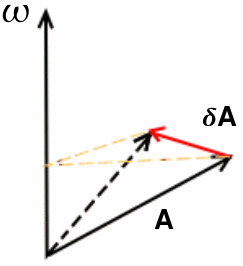Rotating frame transformation
From NMR Wiki
Let's start with a fixed laboratory frame. In that frame, imagine vector A rotating with a positive angular frequency ω. Direction of such rotation of A will be counter-clockwise.
Let's determine derivative  .
.
First calculate  - how much
- how much  changes within time
changes within time  .
.

In the equation above  - rotation angle,
- rotation angle,  - projection of
- projection of  on the plane normal to
on the plane normal to  , and
, and  - unit vector collinear with
- unit vector collinear with 
Notice that  is normal to the plane formed by
is normal to the plane formed by  and
and  .
.
Rotation angle can be expressed as

So, we have

Therefore:



